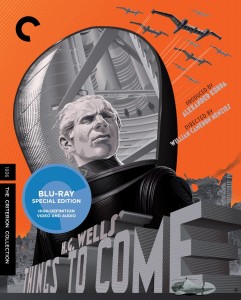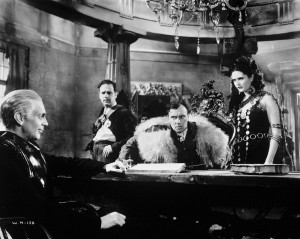I’ve posted about this before – here and here and here and here. What film is that? The H. G. Wells-scripted/William Cameron Menzies-directed Things To Come (1936), of course. Everyone should have a hobby.
The Criterion Collection just released a new, restored version on Blu-Ray. Oh joy!
Here are some stills – all crisp and clear for the first time!
Whenever I teach Philosophy and Film, I lecture about this film at some length. But some semesters I haven’t bothered to give it one of my screening slots because the DVD quality was meh. You can get a free meh copy from the Internet Archive. I’ve often told students they might as well just watch on their laptops. But now! But now!
Let me give you the short version of my previous posts about why this film is awesome and interesting.
First, you can see that the visuals are insane. All kneecaps and curtain rod shoulders and Darth Tweety helmets. ‘Nuff said.
In terms of the history, this film goes with Metropolis. It was Wells’ response to Lang’s film, which he hated. It was supposed to do everything intellectually right that Lang did intellectually wrong. But, in the end, it wasn’t enough fun and Metropolis turned out to be closer to the template for sf film success (even though Metropolis itself stunk up the box office.)
Things To Come is a big budget sf extravaganza that rigorously refuses all the standard, easy satisfactions of the genre. It is a sleek modernist lumberyard of missed opportunities to have more fun, in service of a hare-brained high-concept. That concept is: liberal fascism triumphant! Why don’t we make a film about a bunch of arrogant know-it-all scientist-types who force regular people to behave themselves better – because the scientists know what works, and the regular folks have screwed up the planet! – and it actually works! And in the end there’s a right-wing talk radio uprising, but it is easily put down. Buncha yahoos! I kid you not, that’s the plot.
I call it ‘liberal fascism’ because that actually was Wells’ term (that’s where Jonah Goldberg got it). Curious? Read my original post on the subject.
Anyway, the film is also the first modern zombie movie – in the Dan Drezner sense. (I talked about it here.) It contains a zombie outbreak that is a thinly veiled international relations allegory. It’s the first film in which, instead of a few zombie slaves in the swamp, there are deadly roving armies of the things. So why doesn’t anyone know this? Why isn’t it famous as such? Because it isn’t really a zombie film – not in the emotional sense. It contains all the elements but refuses to do anything fun with them, because that would make the audience sympathize with the ‘wrong’ characters. We never get to see ‘walking dead’-style ‘staying alive against incredible odds’ stuff, although it is implied that must be going on. The zombies are just these poor people – victims of ‘the wandering sickness’ – who lumber towards the living, pathetically, with their arms all zombie-outstretched. Civilization is semi-rebuilt by bastards willing to shoot the sick in the head from a safe distance because (true enough!) ‘it’s them or us!’ But Wells wants us to feel contempt for this sort of savagery. He doesn’t let us indulge any vicarious ‘shooting them in the head’ satisfactions. The only satisfactions we are allowed are those that come with the humane, passive-aggressive deployment of ‘the gas of peace’, when scientist finally figure out how to deal with the bastards who figured out how to deal with the zombies.
The film is so upside-down and backwards that there is actually a successful Iraq War-style ‘ram civilization down their throats’ war, waged from Iraq – where the scientists have set up shop – against all the little tin-pot warlords of England in a not-so-distant 1970 future. (Wells successfully predicts W.W. II, but also predicts that it won’t end until European civilization collapses.)
Wells also had an opportunity for a great villain, but he refused to take it, because it would have been too much fun. Cedric Hardwicke writes in his autobiography, A Victorian In Orbit, that he asked Wells to let his character – the right-wing radio talk show personality who leads the rebellion at the end – dress in a spiff Edwardian suit and drive around in an old-fashioned Rolls Royce, or something or the sort. All this in a future world that is a great big, light bulb-white Le Corbusier model of urban modernism. But Wells forced him to wear a stupid toga. Steampunk was thus averted for half a century. Alas.
In short, it is a fascinating conceptual trainwreck. There’s plenty (especially now – I’m still waiting for my copy!) to dazzle your eyes and amuse your brain, figuring out how and why this just isn’t working. In thinking about the philosophy of sf, in film, I often make these little four-square diagrams of conceptual ways to play some issue, in which one square is crammed with examples – because that’s how Hollywood plays – and the other squares are sparsely populated. Often one of the squares will have only one inhabitant: Things To Come. Big budget rationalist preachiness, unwilling – to a positively silly degree – to extent any sop of sympathy to the sorts of ‘but surely there is wisdom in Will Smith!’ impulses that usually dominate the genre. You’ve never seen it played this way before.
UPDATE: Greetings Krugman readers! Krugman is very right to link to Orwell’s essay on Wells. That’s the trouble alright. “In novels, Utopias, essays, films, pamphlets, the antithesis crops up, always more or less the same. On the one side science, order, progress, internationalism, aeroplanes, steel, concrete, hygiene: on the other side war, nationalism, religion, monarchy, peasants, Greek professors, poets, horses. History as he [Wells] sees it is a series of victories won by the scientific man over the romantic man.” That’s why he wouldn’t let Hardwicke invent steampunk. He made him be a Greek professor. Anyway, I just want to clarify one point I compressed in the post. Wells envisions a strict, two-stage process: fascism, followed by liberalism. (They are obviously different, so ‘liberal fascism’ is kind of like ‘ice steam’ as a name for a process.) In the book version, Wells makes the stages very distinct, and he emphasizes the abuses associated with the early stage more explicitly. The ‘air dictatorship’ has problems. In the movie, this gets compressed to the point of confusion. There is a stage where the airmen are wearing these big black suits, then a stage where they are all wearing white togas. That’s supposed to read as black and white, night and day. But there is no explanation of how something went wrong and needed reversing. And one of the actors – Raymond Massey – plays two different characters: a father and son. The air dictator Cabal, and his more humane successor. One in black, one in white. But somehow the impression is that black is white. It’s all one thing. Yet another problem with the film.







{ 19 comments }
bill benzon 06.23.13 at 10:46 am
Hmmmm . . . . I wonder if this is where Dizzy Gillespie got the title for his tune, “Things to Come”, heard here in a 1946 performance (before Diz’s cheeked had bloomed and his trumpet got up-tilted):
http://www.youtube.com/watch?v=nGjbNNk_9Qo
The movie had probably sunk from view well before that time so there’s probably no connection. But who knows?
Shatterface 06.23.13 at 11:41 am
It’s probably much better known here in the UK: there has been a Blu-ray from Network for at least a year and a DVD for some years before. Don’t know how the quality stands up with the Criterion release because I haven’t seen that version.
Shatterface 06.23.13 at 11:47 am
Just checked Amazon.uk but it doesn’t list the Criterion special features. The Network one has a commentary by Nick Cooper, Ralph Richardson interviewed by Russell Harty in 1975 and an On Reflection feature from 1971 with Brian Aldiss on Wells. Region 2 only though, apparently.
John Holbo 06.23.13 at 12:55 pm
There have been a number of releases – including the colorized one! The cheap disc I’ve had for many years is not terrible but pretty grainy. The stills from Criterion look so much better, and they wouldn’t be releasing it unless they could do a lot better, so I have confidence.
Ben Alpers 06.23.13 at 1:52 pm
The indispensible DVD Beaver has done a comparison of the two THINGS TO COME Blu-rays. Their bottom line seems to be that the Criterion is the better overall package, but they are a bit disappointed by its image quality, which seems “soft” and possibly “over-digitized.” They suspect the problem may lie with an inferior source. Read the whole thing and see image comparisons here..
John Holbo 06.23.13 at 2:41 pm
That’s interesting. I didn’t get the Network one because I suspected (without checking) that it was probably about as good as the one I’ve already got. Sounds like it’s as good as the Criterion one – which is to say, better than what I’ve got. I’m sad to hear that there are problems with the Criterion quality, possibly. We’ll see!
John Holbo 06.23.13 at 2:54 pm
I should probably qualify something from the post: there are a lot of DVD’s that will look ok on your computer or even on your TV but that show their flaws more when you are projecting it onto a big screen in a theatrette. In teaching, I try to make sure that the times that I tell students to come see the show, I have something fairly eye-popping to show them. If you get a (non-colorized) old disc for a few bucks it will probably look ok, and will certainly look better than the Internet Archive version.
novakant 06.23.13 at 7:30 pm
It was Wells’ response to Lang’s film, which he hated.
I just wanted to note that Lang eventually came to hate Metropolis as well:
The main thesis was Mrs. Von Harbou’s, but I am at least 50 percent responsible because I did it. I was not so politically minded in those days as I am now. You cannot make a social-conscious picture in which you say that the intermediary between the hand and the brain is the heart. I mean, that’s a fairy tale – definitely. But I was very interested in machines. Anyway, I didn’t like the picture – thought it was silly and stupid – then, when I saw the astronauts: what else are they but part of a machine? It’s very hard to talk about pictures—should I say now that I like Metropolis because something I have seen in my imagination comes true, when I detested it after it was finished?
Though there might of course have been personal feelings at play (the divorce from von Harbou etc.) I was relieved to hear that, since I hate it too, but love Lang’s “M”.
John Holbo 06.24.13 at 5:46 am
“Metropolis” is a lumberyard of weirdly assorted bits and pieces – visual and thematic and otherwise – that work, potentially, but don’t work right in that particular film, which is a mess. “Metropolis” was born to be turned into music videos. It works better as a Janelle Monae thing than a Fritz Lang thing. “Things To Come”, as I say in the post, is sort of a lumberyard of ideas that are just unworkable. Hence they are philosophically interesting, in a mostly negative sense. WHY will this never work?
zbs 06.24.13 at 6:36 pm
bq. “Metropolis†was born to be turned into music videos.
e.g., Giorgio Moroder
Alain 06.26.13 at 12:54 am
The important thing about “Things to Come” for me is that Arthur C. Clarke took Stanley Kubrick to see it when they were in the planning stages of “2001” in the early 60s. Kubrick absolutely had to see it, Clarke insisted.Kubrick went in that movie house totally innocent about “Things to Come”. When he came out he told Clarke he would never trust him again. He had never seen such a terribly bad movie in all his life.
John Holbo 06.26.13 at 3:59 am
“When he came out he told Clarke he would never trust him again. He had never seen such a terribly bad movie in all his life.”
That’s awesome! I didn’t know that story! That’s perfect.
Brad DeLong 06.26.13 at 9:47 pm
I take it MST3K never did “Things to Come”?
gmoke 06.27.13 at 4:17 am
There is another HG Welles film, The Man Who Could Work Miracles, from the same era. Might make an interesting double feature with Things to Come, which I loved as kid and still enjoy if only for the planes which have what seem to be balconies.
Another double feature might be Lang’s Metropolis with The Woman in the Moon or, if you want to switch directors, The Woman in the Moon with Destination Moon.
John Holbo 06.27.13 at 4:54 am
I acquired and watched “The Woman In The Moon” last year. It’s weirdly … scientific. Along with all the nonsense. I would contrast it with Melies original trip to the moon. But “Destination Moon” is a good one. (Too much like watching the same movie twice, together with “Woman”, however. That’s the sort of thing you can tell the kids and then leave it up to them whether they want to sit through both.) I’ve never taught a lot of films fromthe 50’s. “Day The Earth Stood Still.” Always that one. I’ve made “Forbidden Planet” my 50’s standard fare that shows where “Star Trek” comes from and also gives us paint-by-numbers Freudian ‘sleep of reason breeds monsters’ themes.
John Holbo 06.27.13 at 4:56 am
“I take it MST3K never did “Things to Comeâ€?”
They should. Those guys are Rifftrax now, and still chunking it out on the web. I’ve seriously thought about making a Rifftrax scholarly-comedy offering to go with “Things To Come”. I’ve seen the damn thing 12 times. I might as well record myself snarking about the costumes. (Put it on the list of things to do that’ll never get done.)
Brad DeLong 06.28.13 at 1:43 am
I think only MST3K could rescue “Things to Come” from itself…
Alan 06.28.13 at 2:59 am
I agree so much that Destination Moon and Die Frau im Mond are classics. As I read many years ago (and nomniscient Wikipedia agrees), Frau introduced the countdown for dramatic effect and van Braun et al adopted it for development of the V-2 (even apparently insrcibing the logo of the movie on the base of the prototype). Life deliberating imitating art.
I agree with the choice of TDTESS and FP as great 50s sci-fi. The fact that Leslie Neilsen book-ended his career with that at front and the Naked Gun movies at the end is quite a tribute to duraflexability. (And please do get the Police Squad TV dvds that inspired the films; the episode where Drebin goes undercover as a stand-up comic is tremendous–he only cites punchlines to jokes: “I’m sorry mam, but I don’t think I can take 67 more of those!”)
There are lots of 50s movies verging on something more than good though: This Island Earth, Invasion of the Body-Snatchers, The Incredible Shrinking Man, The Thing, When Worlds Collide, The Quartermass Experiment, Invaders from Mars, The 27th Day, The Colossus of New York, From the Earth to the Moon, and yes–I Married a Monster from Outer Space. Some like Earth to the Moon are just period good as entertainment. But (for example) Colossus is great about identity, and I Married a Monster is interesting about social norms.
Thanks for getting me to think about all this!
The Raven 06.28.13 at 6:51 pm
And none other than Paul Krugman weighs in on the political implications of this, sending us to Orwell’s “Wells, Hitler, and the World State.”
Comments on this entry are closed.